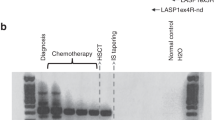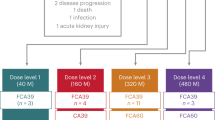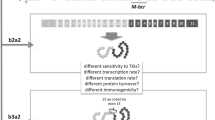Abstract
Kinetics of BCR-ABL transcript elimination and its prognostic implications on relapse were analyzed in patients with chronic myeloid leukemia (CML) after reduced intensity hematopoietic cell transplantation (HCT). In all, 19 CML patients were conditioned with 2 Gy total-body irradiation in combination with (n=14) or without (n=3) fludarabine 3 × 30 mg/m2 (Flu) or 4.5 Gy total lymphoid irradiation (TLI) with Flu and OKT3 3 × 5 mg (n=2) and were treated with cyclosporine (CSP) and mycophenolate mofetil after allogeneic HCT. BCR-ABL transcripts were analyzed by nested RT-PCR and Taqman® RT-PCR on days +28, +56 and +84 after HCT and were evaluated for their association with relapse. Of the 19 patients, 14 achieved sustained remissions of which six had a negative RT-PCR 28 days after HCT. Five patients relapsed +41, +54, +57, +136 and +234 days after HCT. Predictors for relapse were advanced disease stage (P=0.02) and slow reduction of BCR-ABL transcripts at day 28 (P=0.006) and day 56 (P=0.047) post-transplant. We conclude that a complete clearance of BCR-ABL transcripts is achievable within 4 weeks from HCT even after minimal conditioning and that early kinetics of BCR-ABL transcripts significantly correlate with the probability of hematological relapse.
This is a preview of subscription content, access via your institution
Access options
Subscribe to this journal
Receive 12 print issues and online access
$259.00 per year
only $21.58 per issue
Buy this article
- Purchase on Springer Link
- Instant access to full article PDF
Prices may be subject to local taxes which are calculated during checkout




Similar content being viewed by others
References
Thomas ED, Clift RA, Fefer A, Appelbaum FR, Beatty P, Bensinger WI et al. Marrow transplantation for the treatment of chronic myelogenous leukemia. Ann Intern Med 1986; 104: 155–163.
Goldman JM, Apperley JF, Jones L, Marcus R, Goolden AW, Batchelor R et al. Bone marrow transplantation for patients with chronic myeloid leukemia. N Engl J Med 1986; 314: 202–207.
Radich JP, Gehly G, Gooley T, Bryant E, Clift RA, Collins S et al. Polymerase chain reaction detection of the BCR-ABL fusion transcript after allogeneic marrow transplantation for chronic myeloid leukemia: results and implications in 346 patients. Blood 1995; 85: 2632–2638.
Molina SR AJ . Hematopoietic stem cell transplantation in older adults. Handbook of Bone Marrow Transplantation, In: Rowe JM, Lazarus HM Carella AM (eds), 1st edn. London, UK: Martin Dunitz Ltd, 2000, pp 111–137.
Storb R, Yu C, Barnett T, Wagner JL, Deeg HJ, Nash RA et al. Stable mixed hematopoietic chimerism in dog leukocyte antigen-identical littermate dogs given lymph node irradiation before and pharmacologic immunosuppression after marrow transplantation. Blood 1999; 94: 1131–1136.
McSweeney PA, Niederwieser D, Shizuru JA, Sandmaier BM, Molina AJ, Maloney DG et al. Hematopoietic cell transplantation in older patients with hematologic malignancies: replacing high-dose cytotoxic therapy with graft-versus-tumor effects. Blood 2001; 97: 3390–3400.
Niederwieser D, Maris M, Shizuru JA, Petersdorf E, Hegenbart U, Sandmaier BM et al. Low-dose total body irradiation (TBI) and fludarabine followed by hematopoietic cell transplantation (HCT) from HLA-matched or mismatched unrelated donors and postgrafting immunosuppression with cyclosporine and mycophenolate mofetil (MMF) can induce durable complete chimerism and sustained remissions in patients with hematological diseases. Blood 2003; 101: 1620–1629.
Bryant E, Martin PJ . Documentation of engraftment and characterization of chimerism following hematopoietic cell transplantation. In: Thomas ED, Blume KG, Forman SJ (eds). Hematopoietic Cell Transplantation, 2nd edn. Boston: Blackwell Science, 1999, 197–206.
Olavarria E, Kanfer E, Szydlo R, Kaeda J, Rezvani K, Cwynarski K et al. Early detection of BCR-ABL transcripts by quantitative reverse transcriptase-polymerase chain reaction predicts outcome after allogeneic stem cell transplantation for chronic myeloid leukemia. Blood 2001; 97: 1560–1565.
Deininger MWN, Goldman JM, Lydon N, Melo JV . The tyrosine kinase inhibitor CGP57148B selectively inhibits the growth of BCR-ABL-positive cells. Blood 1997; 90: 3691–3698.
Cross NC, Hughes TP, Feng L, O'Shea P, Bungey J, Marks DI et al. Minimal residual disease after allogeneic bone marrow transplantation for chronic myeloid leukaemia in first chronic phase: correlations with acute graft-versus-host disease and relapse. Br J Haematol 1993; 84: 67–74.
Kohler T, Schill C, Deininger MW, Krahl R, Borchert S, Hasenclever D et al. High Bad and Bax mRNA expression correlate with negative outcome in acute myeloid leukemia (AML). Leukemia 2002; 16: 22–29.
Lange T, Gunther C, Kohler T, Krahl R, Musiol S, Leiblein S et al. High levels of BAX, low levels of MRP-1, and high platelets are independent predictors of response to imatinib in myeloid blast crisis of CML. Blood 2003; 101: 2152–2155.
Lange T, Bumm T, Otto S, Al-Ali HK, Kovacs I, Krug D et al. Quantitative RT-PCR should not replace conventional cytogenetics for monitoring CML patients during the early phase of Imatinib therapy. Haematologica 2004; 89: 49–57.
Kottaridis PD, Milligan DW, Chopra R, Chakraverty RK, Chakrabarti S, Robinson S et al. In vivo CAMPATH-1H prevents graft-versus-host disease following nonmyeloablative stem cell transplantation. Blood 2000; 96: 2419–2425.
Giralt S, Thall PF, Khouri I, Wang X, Braunschweig I, Ippolitti C et al. Melphalan and purine analog-containing preparative regimens: reduced-intensity conditioning for patients with hematologic malignancies undergoing allogeneic progenitor cell transplantation. Blood 2001; 97: 631–637.
Uzunel M, Mattsson J, Brune M, Johansson JE, Aschan J, Ringden O . Kinetics of minimal residual disease and chimerism in patients with chronic myeloid leukemia after nonmyeloablative conditioning and allogeneic stem cell transplantation. Blood 2003; 101: 469–472.
Raanani P, Dazzi F, Sohal J, Szydlo RM, van Rhee F, Reiter A et al. The rate and kinetics of molecular response to donor leucocyte transfusions in chronic myeloid leukaemia patients treated for relapse after allogeneic bone marrow transplantation. Br J Haematol 1997; 99: 945–950.
Dazzi F, Szydlo RM, Cross NC, Craddock C, Kaeda J, Kanfer E et al. Durability of responses following donor lymphocyte infusions for patients who relapse after allogeneic stem cell transplantation for chronic myeloid leukemia. Blood 2000; 96: 2712–2716.
Baurmann H, Nagel S, Binder T, Neubauer A, Siegert W, Huhn D . Kinetics of the graft-versus-leukemia response after donor leukocyte infusions for relapsed chronic myeloid leukemia after allogeneic bone marrow transplantation. Blood 1998; 92: 3582–3590.
Elmaagacli AH, Beelen DW, Opalka B, Seeber S, Schaefer UW . The amount of BCR-ABL fusion transcripts detected by the real-time quantitative polymerase chain reaction method in patients with Philadelphia chromosome positive chronic myeloid leukemia correlates with the disease stage. Ann Hematol 2000; 79: 424–431.
Barbany G, Hagberg A, Olsson-Stromberg U, Simonsson B, Syvanen AC, Landegren U . Manifold-assisted reverse transcription-PCR with real-time detection for measurement of the BCR-ABL fusion transcript in chronic myeloid leukemia patients. Clin Chem 2000; 46: 913–920.
Mensink E, van de LA, Schattenberg A, Linders E, Schaap N, Geurts vk et al. Quantitation of minimal residual disease in Philadelphia chromosome positive chronic myeloid leukaemia patients using real-time quantitative RT-PCR. Br J Haematol 1998; 102: 768–774.
Preudhomme C, Revillion F, Merlat A, Hornez L, Roumier C, Duflos-Grardel N et al. Detection of BCR-ABL transcripts in chronic myeloid leukemia (CML) using a ‘real time’ quantitative RT-PCR assay. Leukemia 1999; 13: 957–964.
Hochhaus A, Weisser A, La Rosee P, Emig M, Muller MC, Saussele S et al. Detection and quantification of residual disease in chronic myelogenous leukemia. Leukemia 2000; 14: 998–1005.
Eder M, Battmer K, Kafert S, Stucki A, Ganser A, Hertenstein B . Monitoring of BCR-ABL expression using real-time RT-PCR in CML after bone marrow or peripheral blood stem cell transplantation. Leukemia 1999; 13: 1383–1389.
Lin F, Goldman JM, Cross NC . A comparison of the sensitivity of blood and bone marrow for the detection of minimal residual disease in chronic myeloid leukaemia. Br J Haematol 1994; 86: 683–685.
Radich JP, Gooley T, Bryant E, Chauncey T, Clift R, Beppu L et al. The significance of bcr-abl molecular detection in chronic myeloid leukemia patients ‘late,’ 18 months or more after transplantation. Blood 2001; 98: 1701–1707.
Lin F, van Rhee F, Goldman JM, Cross NC . Kinetics of increasing BCR-ABL transcript numbers in chronic myeloid leukemia patients who relapse after bone marrow transplantation. Blood 1996; 87: 4473–4478.
Buonamici S, Ottaviani E, Testoni N, Montefusco V, Visani G, Bonifazi F et al. Real-time quantitation of minimal residual disease in inv(16)-positive acute myeloid leukemia may indicate risk for clinical relapse and may identify patients in a curable state. Blood 2002; 99: 443.
Kantarjian HM, O'Brien S, Cortes JE, Giralt SA, Rios MB, Shan J et al. Imatinib mesylate therapy for relapse after allogeneic stem cell transplantation for chronic myelogenous leukemia. Blood 2002; 100: 1590.
Acknowledgements
We thank the laboratory and medical staff of the University of Leipzig for their important contribution to this study and especially Ines Kovasc and Scarlet Musiol for their technical expertise in the PCR analysis.
Author information
Authors and Affiliations
Corresponding author
Additional information
Supported by: Deutsche Krebshilfe, German Competence Network for Acute and Chronic Leukemias
Rights and permissions
About this article
Cite this article
Lange, T., Deininger, M., Brand, R. et al. BCR-ABL transcripts are early predictors for hematological relapse in chronic myeloid leukemia after hematopoietic cell transplantation with reduced intensity conditioning. Leukemia 18, 1468–1475 (2004). https://doi.org/10.1038/sj.leu.2403425
Received:
Accepted:
Published:
Issue Date:
DOI: https://doi.org/10.1038/sj.leu.2403425
Keywords
This article is cited by
-
Isolated central nervous system relapse of chronic myeloid leukemia after allogeneic hematopoietic stem cell transplantation
BMC Blood Disorders (2012)
-
Promising Role of Reduced-Toxicity Hematopoietic Stem Cell Transplantation (PART-I)
Stem Cell Reviews and Reports (2012)
-
Monitoring of WT1 expression in PB and CD34+ donor chimerism of BM predicts early relapse in AML and MDS patients after hematopoietic cell transplantation with reduced-intensity conditioning
Leukemia (2011)
-
Minimal residual disease diagnostics in myeloid malignancies in the post transplant period
Bone Marrow Transplantation (2008)
-
Prediction of relapse by day 100 BCR-ABL quantification after allogeneic stem cell transplantation for chronic myeloid leukemia
Leukemia (2006)



